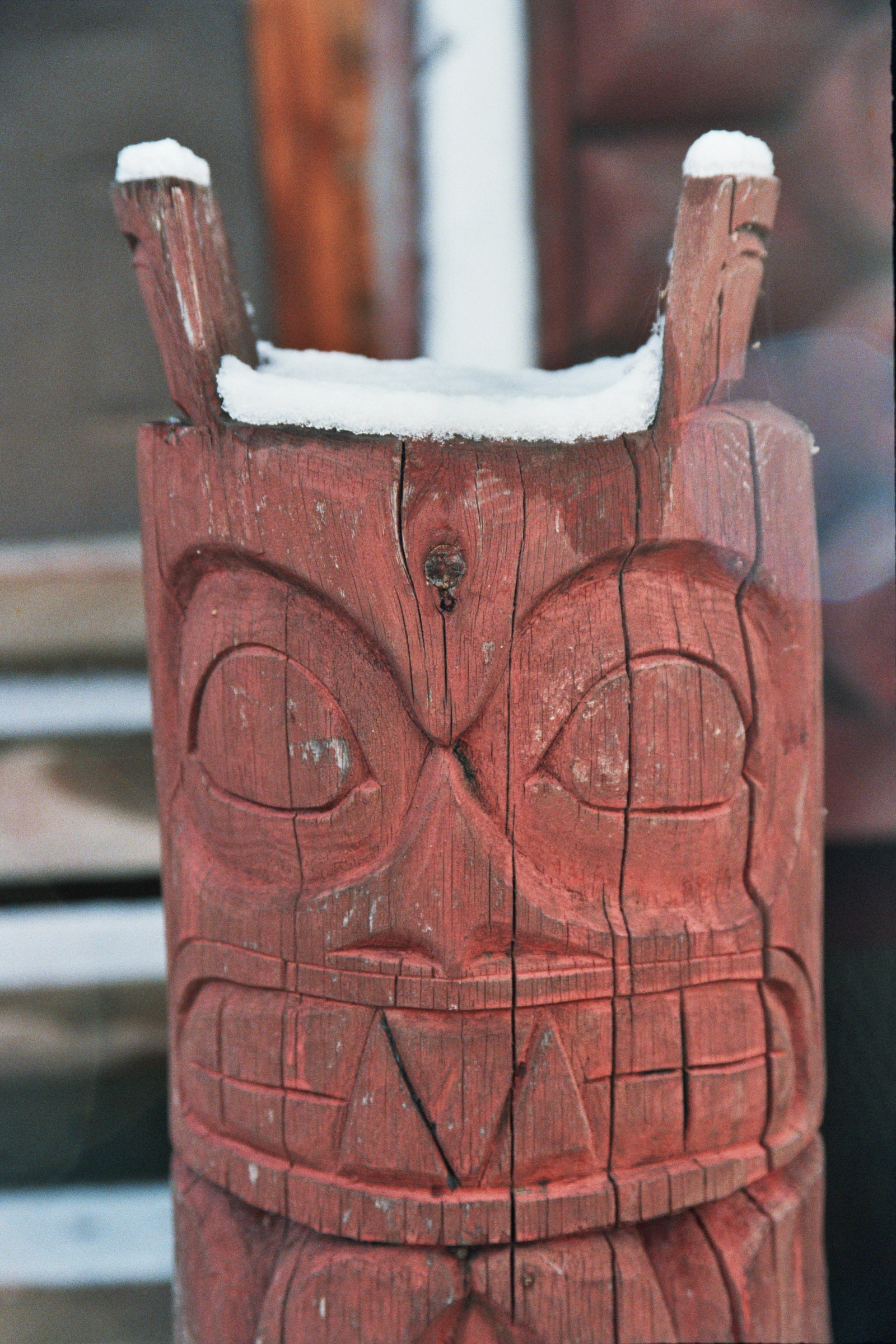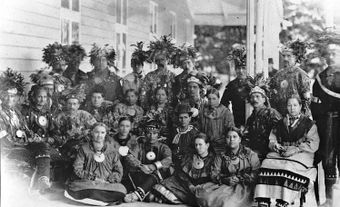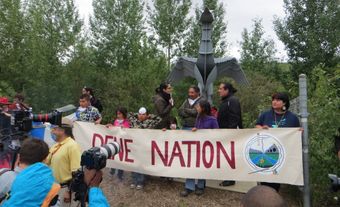Population and Territory
Dakelh territory comprises approximately 76,000 km2 in the Interior Plateau region of British Columbia, bounded on the east by the Rocky Mountains, in the north by the Omineca Mountains, and to the west by the Pacific Coast. In the 2016 census, 7,810 people claimed to have Dakelh ancestry. (See also Plateau Indigenous Peoples in Canada and Indigenous Territory.)
Pre-contact Life
Dakelh winter villages were mainly located at the outlets of lakes or the confluences of rivers, or adjacent to strategic river canyons. The traditional economy of the Dakelh was based on fishing, especially salmon and lake fish. Salmon fishing was carried out by using weirs (enclosures) across river mouths or by spearing salmon along rivers.
The Dakelh also hunted large and small game, including bear, marmots and beaver. Caribou was particularly important to traditional ways of life until the mid-1800s; moose became similarly important after 1900. They gathered berries and plants to supplement their diet.
The Dakelh used coastal trade routes to exchange hides, dried berries and meats; the routes were known as “Grease Trails” because many of the products traded along these routes were created using fish oils or grease. The Dakelh also had extensive trade ties with neighbouring groups, such as the Nuxalk, Gitxsan and Sekani.
Society and Culture
Lower Dakelh social organization was based on bilateral kinship groups centred on extended families consisting of brothers, their wives and children, and married sons’ families. Each group (known as a sedeku) was associated with a hunting territory and fishing and gathering sites.
Upper and Central Dakelh had matrilineal descent groups or clans associated with resource-use areas (known as keyoh) and fishing sites. Heads of kinship groups and clans were known as deneza.
Potlatches, the ceremonial distribution of goods and food, were held by clans to commemorate deaths, the inheritance of names and other special occasions. Members of each community were connected by extensive kinship ties which served as a framework for the inheritance of traplines and the exchange of goods and services. Oblate missionaries established a mission at Stuart Lake in 1873 and discouraged potlatches and other customs.
Language
Linguistically, the Dakelh are Dene and comprise three major subgroupings based on differences in dialect and culture: Upper Dakelh or Babine, located along the Bulkley River and Babine Lake in the Skeena River watershed; Central Dakelh in the Stuart Lake and Fraser Lake basins in the Fraser River watershed; and Lower Dakelh in the Blackwater River region. The Canadian census does not separate Babine, Central Dakelh, and Southern Dakelh speakers, and in 2016, it reported approximately 1,265 Carrier (Dakelh) language speakers. (See alsoIndigenous Languages in Canada.)
Colonial History
Alexander Mackenzie and other fur traders of the Northwest Company were the first Europeans to enter Dakelh territory in 1793. (See also Fur Trade.) In order to get to this area however, they had to pass through Sekani lands, and therefore learned about the Dakelh from the Sekani. It is for this reason that the Sekani name for Dakelh — Aghele — is the name Europeans translated and used to refer to the Dakelh.
After the establishment of fur trade posts in the Dakelh area in the early 1800s (e.g., Fort St. James at Stuart Lake in 1806), the Dakelh traded salmon and furs to fur-trading companies (North West Company until 1821; the Hudson’s Bay Company after 1821). Because of a mission and trading post located at Stuart Lake, Fort St. James became an important centre for seasonal gatherings of Dakelh from throughout the region.
Diseases such as smallpox and measles in the 1800s and influenza in 1918 reduced the Dakelh populations, which reached a low point in the late 1920s. Reserves were allocated in 1871 and in the 1890s.
After the completion of a railway line in the Northern Interior in 1914, the Dakelh became involved in logging and seasonal wage labour while maintaining hunting, trapping and fishing activities. This pattern remains important in some Dakelh communities.
By 1911, weirs (enclosures) had been banned from use on salmon streams in the Fraser River and Skeena River watersheds; in 1913–14 rock slides in the Hells Gate section of the Fraser River severely reduced the amount of salmon reaching the Stuart Lake and Fraser Lake area, resulting in increased use of lakefish, hunting and trapping.
Activism
In the 1980s, the westernmost Dakelh groups, the Wet'suwet 'en, along with the Gitxsan of the Skeena River, went to court for recognition of Aboriginal title in what is known as the Delgamuukw case (1997). The Supreme Court of Canada observed that Aboriginal title constituted an ancestral right protected by section 35 (1) of the Constitution Act, 1982. Influenced by the Calder case (1973), the ruling in the Delgamuukw case had an impact on other court cases about Aboriginal rights and title, including in the Tsilhqot’in case (2014). (See alsoIndigenous Political Organization and Activism in Canada.)
Contemporary Life
Carrier Sekani Tribal Council (CSTC) is a political organization that represents seven First Nations: Ts’il Kaz Koh (Burns Lake Band), Nadleh Whut’en, Saik’uz, Stellat’en, Takla Lake, Tl’azt’en, and Wet’suwet’en. According to the CSTC, the organization also offers “technical and professional services to its member-nations in the areas of fisheries, education, economic development, community and infrastructure planning, forestry, financial management and negotiations.”
Carrier-Chilcotin Tribal Council (CCTC) has four member communities: Lhoosk’uz Dené Nation, Lhtako Dené Nation, Tl’esqox of the Tsilhqot’in, and Ulkatcho First Nation. The council describes itself as “an effective and progressive organization that contributes to the unity and well-being of the CCTC communities and citizens through the delivery of quality programs and services which respect our aboriginal culture, traditions and values.”

 Share on Facebook
Share on Facebook Share on X
Share on X Share by Email
Share by Email Share on Google Classroom
Share on Google Classroom







